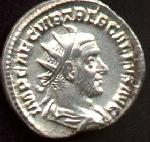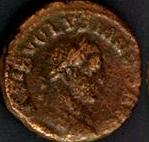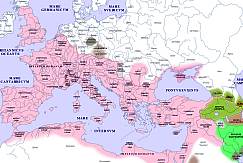 Volusianus
Volusianus
 Trebonianus
Gallus
Trebonianus
Gallus

An Online Encyclopedia of Roman Emperors
Trebonianus Gallus (251-253 A.D.) and Gaius Vibius Volusianus (251-253 A.D.)
R. Scott Moore
Indiana University of Pennsylvania
 Trebonianus
Gallus
Trebonianus
Gallus Volusianus
Volusianus
Early Career and Accession
Gaius Vibius Trebonianus Gallus was born around the year 206 AD in Perugia (Italy). He married Afinia Gemina Baebiana and had two children with her, a son Gaius Vibius Volusianus and a daughter Vibia Galla. He appears to have had a traditional political career, serving as a senator and as consul. In 250, he became governor of Upper Moesia and as governor became deeply involved with Decius' Danube wars, including the successful defense of the city of Novae.[[1]]
After repeated incursions into Moesia and Dacia by the Goths, the emperor Decius and his son Herennius Etruscus led a military expedition into the Lower Danube and forced the Goths to withdraw. In an effort to trap the retreating Goths, Decius was tricked into fighting from a poor position at Abrittus in June of 251 AD and he and his son were killed before a relief force could arrive.[[2]] With the death of Decius, the army immediately proclaimed Trebonianus Gallus as emperor. He adopted Decius' surviving son Hostilian, who was too young to succeed his father, and proclaimed him as co-emperor. He also elevated his son Volusianus to the rank of Caesar.[[3]]
Gallus' Reign
Concerned with reaching Rome quickly and solidifying his position as emperor, Gallus signed an unpopular peace treaty with the Goths. In return for their withdrawal, he agreed to allow them to keep the loot and Roman prisoners gained from their incursions and to pay them an annual tribute.[[4]] While this allowed him to proceed immediately to Rome, when he arrived he found the city suffering from the plague.[[5]] Soon after the imperial arrival in the city, Hostiliancontracted the plague and died in July 251 AD. Gallus then elevated his son Volusianus to the position of co-emperor.[[6]]
As the plague continued to ravage the city, Gallus gained popular support within the city by providing proper burials for all plague victims, even those too poor to afford it.[[7]] While Gallus acted decisively regarding the plague in Rome, in all other matters, both internal and foreign, he was either slow to react or failed to take any serious action at all.[[8]] There were rumors that he renewed the persecution of Christians, but the only evidence is the arrest and imprisonment of Pope Cornelius in 252 AD.[[9]]
In 252 AD, the Persian king Shapur I attacked the eastern frontier, perhaps due to a dispute with the Romans over control of Armenia.[[10]] Advancing up the Euphrates, Shapur quickly defeated the the Roman forces at the battle of Barbalissos and soon controlled most of the province of Syria. In 253 AD, he completed the annexation of Syria with the capture of its capital city of Antioch.[[11]] Gallus did not take any action to stop Shapur's advances or bolster the eastern defenses against further excursions into Roman controlled territory.
While the Persians were attacking the eastern frontier, trouble also occurred on the northern frontier. Gallus' replacement as governor of Upper Moesia, Aemilius Aemilianus, refused to pay the annual tribute to the Goths agreed to by Gallus in 251 AD. In retaliation for the Roman breach of the peace treaty, the Goths once again invaded the Lower Danube. Aemilianus gathered an army and was able to defeat the invading Goths and as a reward, his grateful troops proclaimed him as emperor.[[12]] He immediately stripped the area of troops and marched his army towards Rome. In an effort to prevent Aemilianus from reaching Italy, Gallus and Volusianus gathered an army and marched north. Gallus also requested Publius Licinius Valerianus to bring reinforcements south from Germany to join up with his forces marching north, but they never arrived. Gallus' army moved slowly and had only reached Interamna by August of 253 AD when word reached them that Aemilianus had already crossed into Italy with a large force and was rapidly approaching. Learning of this and fearing defeat, Gallus' troops mutinied and murdered the two co-emperors.[[13]]
Notes
[[1]] Wolfram, History of the Goths, 45-46.
[[2]] Some sources imply that Gallus either actively conspired with the Goths or was deliberately slow in coming to assist Decius hoping that he would be killed. Zosimus 1.23, Eusebius 7.1.
[[5]] For a description of the plague see Pontius, Life and Passion of Cyprian, in Cyprian, Writings, 1.21.
[[6]] Some sources imply that Gallus had the young co-emperor assasinated. Zosimus 1.25.
[[7]] Brauer, The Age of the Soldier Emperors, 61.
[[9]] Eusebius 7.1, Liber Pontificalis 22.
[[10]] Zosimus 1.27, Zonaras 12.21.
[[11]] Maricq, "Res Gestae Divi Saporis," 295, Frye, The History of Ancient Iran, 369-373, Zosimus 1.27
[[12]] Zosimus 1.28, Jordanes Getica 105.
Primary Source Bibliography
Eusebius. Ecclesiastical History.
Jordanes. Getica.
Liber Pontificalis.
Pontius the Deacon. Life and Passion of Cyprian.
Zonaras, Johannes. Epitome Historiarum.
Zosimus. Historia Nova.
Bibliography
Brauer, George C., Jr. The Age of the Soldier Emperors. Park Ridge, New Jersey, 1975.
Frye, R.N. The History of Ancient Iran. Munchen, 1983.
Hanslick, Rudolf. "Vibius Trebonianus Gallus Augustus." RE II 16:1984.
Hornblower, Simon and Anthony Spawforth, eds. The Oxford Classical Dictionary. 3rd edition. Oxford, 1996. S.v. "Vibius Trebonianus Gallus" by John Frederick Drinkwater.
Maricq, A. "Res Gestae Divi Saporis" Syria 35 (1958), 295.
Millar, Fergus. The Roman Near East: 31 BC - AD 337. London, 1993.
Wolfram, Herwig. Translated by Thomas J. Dunlap. History of the Goths.
2nd edition. Berkeley, 1988.
Copyright (C) 2002, R. Scott Moore. This file may be copied on the condition that the entire contents, including the header and this copyright notice, remain intact.
Comments to: R. Scott Moore
Updated: 1 July 2002
For more detailed geographical information, please use the DIR/ORBAntique and Medieval Atlas below. Click on the appropriate part of the map below to access large area maps.
